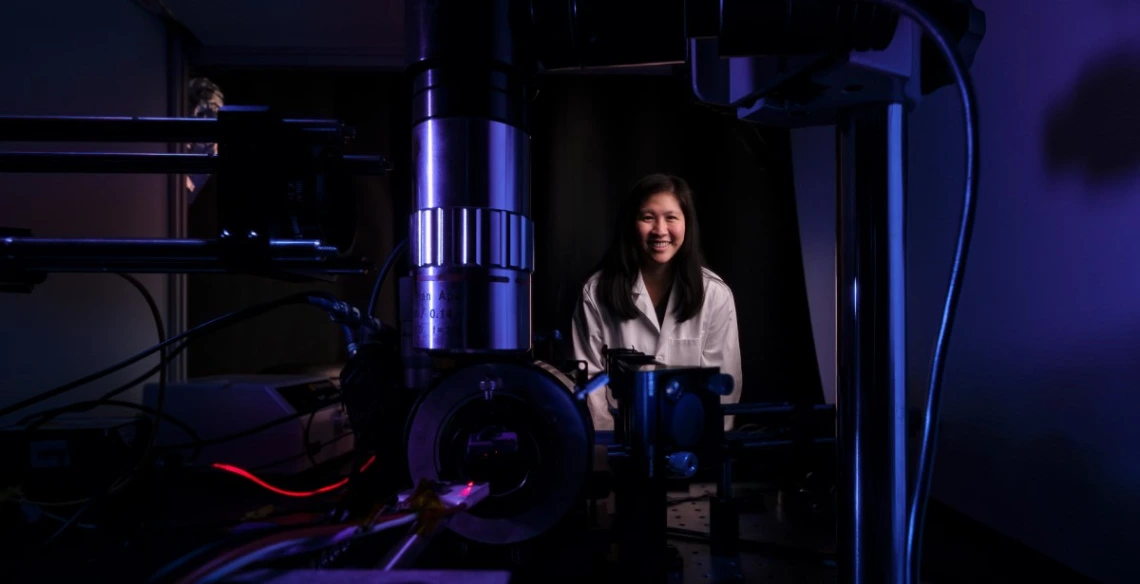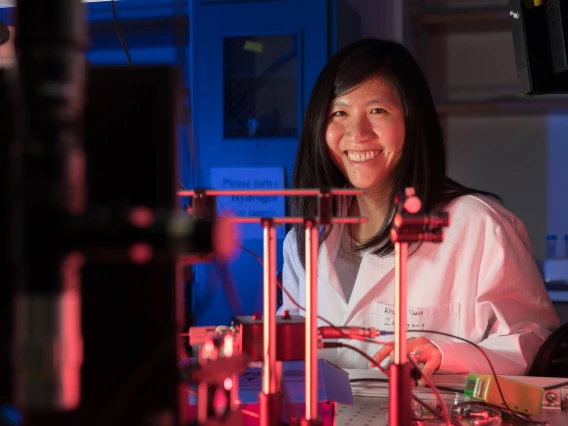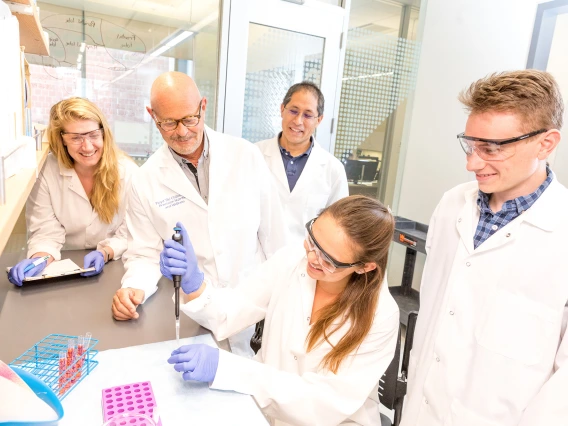The Nose Knows: CAREER Awardee Developing Bioinspired Optical Sniffer Sensor
With a prestigious grant from the National Science Foundation, a biomedical engineering and optical sciences researcher is creating a device that can sniff out diseases, dangerous chemicals and other substances with the sensitivity of a bloodhound.

Judith Su of biomedical enginering and optical sciences and engineering is a recipient of a 2023 CAREER Award from the National Science Foundation.
The human nose, which has around 6 million olfactory receptors, can distinguish between at least 1 trillion different odors. Dogs have about 300 million of these receptors, with some scientists estimating their sense of smell is up to 100,000 times more powerful than humans’. This allows dogs to detect the scent of dangerous materials like bombs and illicit substances, as well as medical conditions such as COVID-19 and Parkinson’s disease.
University of Arizona assistant professor Judith Su is developing an optical nose “as sensitive as a bloodhound’s and as selective as an insect’s” to detect volatile organic compounds (VOCs), compounds with high vapor pressure at room temperature which emit odors. The optical nose could be used to detect anything a canine nose could, without the risk of putting real dogs in potentially dangerous situations.
“It would be really impactful to make an artificial dog to sense things in a noninvasive way, just through breath and vapors from our skin” said Su, a professor of biomedical engineering, optical sciences and the BIO5 Institute.
The work is funded by a $500,000 National Science Foundation CAREER Award, the organization’s most prestigious award in support of early-career faculty.
A Super-Powered FLOWER
Electronic noses, or e-noses, have been around for several decades, but even the most advanced are quite limited, with the ability to detect just a few dozen odors by detecting how scents interact with a synthetic polymer coating. They’re also unstable and slow. Su and her collaborators are creating a much more capable alternative by combining hypersensitive olfactory receptors with a powerful optical sensing platform developed in Su’s Little Sensor Lab.
Olfactory receptors are chemical receptors in cell membranes. When triggered by odorous compounds, they send nerve impulses to the brain, resulting in the experience of smell.
“Your olfactory receptors have been refined over thousands of years of evolution for the purpose of detecting these odorants,” Su said. “People haven’t really been able to use them in combination with sensors before because it’s a challenge to produce them and keep them in working form. When they’re present in your body, that’s the environment that they’re happy in. Once they are outside the body, how do you maintain that in a functional form?”
Su is working with collaborators at the California Institute of Technology and the University of South Florida who can manufacture mutated olfactory receptors with increased sensitivity to specific smells. These will be combined with Su’s Frequency Locked Optical Whispering Evanescent Resonator, or FLOWER.
FLOWER is an optical sensing platform that can detect ultra-small levels of molecules – in the past, it’s detected molecules like disease particles and toxic industrial chemicals. The technology works by sending waves of light around a tiny ring (about the size of a grain of table salt) about 6,000 times per nanosecond.
If FLOWER is set up to detect a toxic chemical in a water sample and the chemical is present, the chemical will alter the wave of light very slightly each time it makes the loop. Because the loop is done so many times so quickly, this slight effect is magnified enough to become detectable. FLOWER can be adapted to sense different kinds of molecules. In this case, it will work in tandem with specialized olfactory receptors to detect VOCs.
“This is simply changing what we’re putting on that surface for the selectivity,” Su said. “In this case, a human receptor used for smell.”
Sniffing Out Solutions
Detecting scents is new territory for FLOWER. One challenge is that VOCs usually exist in a gaseous state, rather than liquid. Along the way, the team may experiment with ways to imitate how humans and canines experience scent, such as coating the sensors in a mucous-like membrane or using an airflow that imitates the action of sniffing. Ultimately, Su envisions using hundreds of scent receptors, mirroring the way mammalian noses work.
“Ideally, we will someday have an array of sensors, each with a different olfactory receptor,” Su said. “It would be able to distinguish trillions of odors, just like a human would. Or, eventually, we can go larger, and get something as sensitive as a bloodhound.”
Su and her team will first test their setup using common aromatic compounds such as benzene, which is one of the compounds responsible for the scent of gasoline, and toluene, the smell of paint thinner. From there, they plan to introduce more complex scents. Eventually, they envision using machine learning to teach the system how to recognize increasingly nuanced combinations.
Su’s work also includes an educational component. She and her team will create a refractometer kit for K-12 students all over the world to perform food and water quality field studies. Additionally, they will create interactive learning resources high school teachers can use in their classes.





